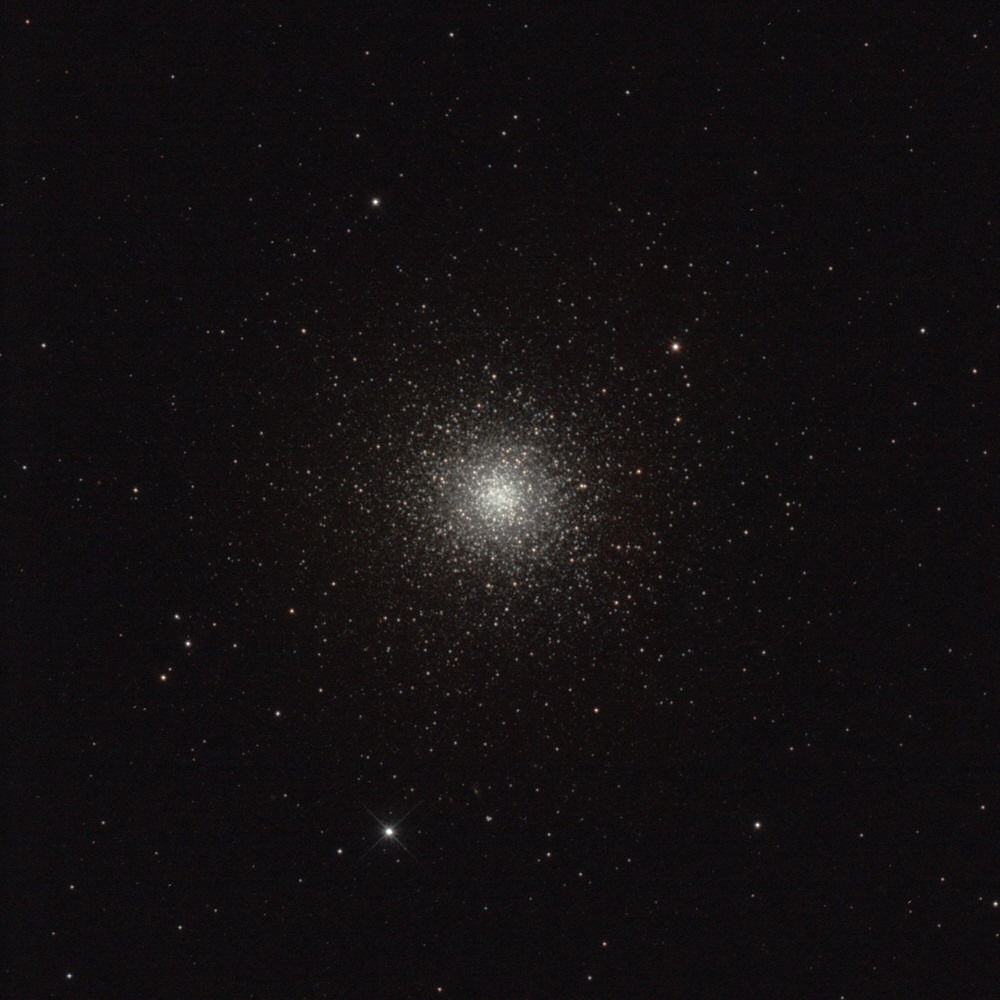
M3 is one of the richest globular clusters in the sky, containing an estimated half a million stars. Its magnitude is 6.2, making it barely visible to the naked eye under excellent conditions. At a distance of about 34,000 light years, it is further away than the center of our Galaxy, the Milky Way. Its apparent diameter of 16.2 arc minutes corresponds to a linear extension of about 160 light years. Its brightest stars in the globular cluster are of mag 12.7. This cluster is approaching us at 149 km/s.
Like most other globular clusters, M3 is located in the Halo, a sphere around our Galaxy having a diameter of approx. 200,000 light years and containing globular clusters and a few old field stars.
 M3, Wide Field, nearly the full frame of this photograph.
M3, Wide Field, nearly the full frame of this photograph.
Exposure Data
Observing Hints (for M3 and NGC 5466)
M3 is one of the finest globular clusters in the northern sky, only M13 outclasses it in size and magnitude. M3 is smaller and 0.5 magnitudes less bright than M13, but has a more compact core and is therefore aesthetically quite as pleasing as M13.
The globular cluster is located in the southern region of Canes Venatici, near to the border to Bootes, in a region sparsely populated with stars, it is therefore not very easy to find it. Starting at Beta Coma Berenices, and using a telescope, you can position Beta Com a little bit (0.5 degrees) south of the center of a wide-angle eyepiece and go 7 degrees due east. M3 should eventually slip into the field of view. It is situated in a flat right-angled triangle with two 6th magnitude stars, with M3 being at the right angle.
If the sky is not completely dark at your observation site, 4.3 mag Beta Com might not be easily seen with the naked eye. In that case a different approach to M3 may be preferable: Starting at 2.7 mag Eta Bootes, move north and slightly west, and keep that direction. After 3 degrees, a pair of 5th/6th magnitude stars will cross the field of view. After additional 4.5 degrees a single star of the same brightness will cross the field. 3 more degrees, and you will see the flat triangle including M3 described above. Ok, that line is not exactly straight, but it can easily be followed in the finderscope, and should bring you to M3 even under a bright suburban sky.
M3 is one of the objects that can be reasonably observed under a light- polluted sky, but of course a dark country sky is to be preferred. It takes a quality 4" refractor to resolve the cluster, as the brightest stars are of 13th magnitude. A fine 6" scope will show M3 as quite a showpiece which can take higher magnification and still looks nicely compact. With an 8-inch aperture, M3 can look spectacular, but the experience of seeing M3 in a large-aperture telescope such as an 18" Dob is breathtaking, the field-of-view being full of glittering points of light, looking much like fireworks. Of course, it takes good Seeing to see the stars as nice tight pinpoints. 200-300x is the optimal magnification for M3.
5.5 degrees east of M3 there is a less-known globular cluster designated NGC 5466. It is 1/3 smaller than M3, and of 9th magnitude. It can be seen in a 4- inch or 6-inch telescope as diffuse patch of light, spotting it is not too difficult. Not so easy is resolving the cluster into individual stars as the brightest of them have magnitude 14, and they are few. In a 6" telescope it is possible to see them, but if you magnify too much the cluster seemingly disappears, i.e. becomes to faint to be observed as NGC 5466 is a globular of the less compact sort. In an 8" telescope or greater the task becomes easier.
Indirect vision is a key to seeing more and fainter stars in globular clusters, as always in deep-sky astronomy.